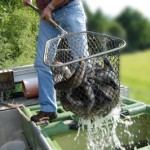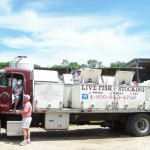When a horse is too thin, what is the best way to help him gain weight? The answer may not be the same in every situation so we need more information to make a good recommendation. First, we need to know if the horse truly does need to gain weight. Horse owners can disagree about the ideal weight or body condition for their horses and what one person thinks is too thin may be just right to another person. To eliminate opinions from the equation, we need to be working from an objective position of body condition score (BCS). The BCS establishes a score from 1 – 9 for how fat or thin a horse is; a score of 1 is a severely starved horse and a score of 9 is an extremely obese horse. With very few exceptions, horses should be maintained in a moderate body condition score of 5 – 6. Horses in this range will have no visible ribs showing but the ribs will be easy to feel. Essentially, if you can see ribs showing, the horse is too thin and if you can’t find their ribs the horse is too fat. A complete description of the scoring system can be found at horse.purinamills.com.
If we’ve established that the horse indeed is too thin and needs to gain weight, we now need to determine why the horse is underweight. We need to ask questions:
1. Is the horse being fed enough calories to support the lifestyle?
a. Is he getting enough feed or a high enough quality feed to support his lifestyle (age and activity level)?
b. Is he being fed enough hay or pasture, or is the quality of hay or pasture poor?
2. Has the horse been effectively dewormed to control internal parasites?
a. Resistant worms are becoming a more frequent problem and deworming programs that have worked for years may not be doing the job in some horses now.
3. Is there a health issue preventing the horse from properly utilizing feed or that is causing nutrient requirements above normal levels?
a. Are there dental problems due to age or inadequate dental care causing compromised chewing? Are the dental problems such that the horse can’t or won’t eat enough hay or pasture or drops a large amount of feed when eating.
b. Does the horse possibly have gastric ulcers, colonic ulcers or other inflammation of the digestive tract that is causing a decline in digestion or intake of feed and hay?
c. Is there some intestinal issue preventing proper digestion and absorption of nutrients from the diet?
Answering the first question is fairly simple and straight forward and is the easiest situation to correct. Evaluate the current diet and make appropriate adjustments to improve the amount and level of nutrition being offered. Weigh the feed and hay being fed with a scale to determine actual pounds per day the horse is eating. Compare with feeding directions on the feed tag and determine if the amount being fed is adequate for the situation. Horses should be eating a minimum of 1.0 pounds of hay per 100 pounds of body weight (10 pounds of hay for a 1000 pound horse). Horses will very often not eat all of their hay when the hay quality is poor, so be sure to weigh the amount horses are actually eating, not just what may be offered. If the hay quality is low or the horse isn’t eating at least the minimum amount, an alternative hay source needs to be located or be replaced with a bagged complete feed/hay stretcher that includes adequate fiber to replace hay. If the horse is out on pasture, the pasture needs to be evaluated to determine if it is truly grazing, providing nutrition, or is it just a place to hang out and nibble around. Pastures can have a green color to them but be weeds or poor quality grasses and not provide adequate nutrition to sustain horses in good shape. Pasture quality and nutritional values vary significantly depending on fertilization and many other pasture management and weather-related factors. On average, due to the higher water content of pasture, horses must eat 30 – 40 lbs of fresh pasture to equal the dry matter intake of 10 lbs of hay. Pastures generally should be at least 3 – 4 inches tall to provide sufficient grazing to supply adequate fiber and nutrition.
An average 1100 pound horse at maintenance requires 16,700 calories per day. This can be achieved by something as simple as 15 – 20 pounds of hay and 1 – 2 pounds of Purina® Nature’s Essentials Enrich 32®. As the level of activity or individual metabolism of the horse increases, it becomes necessary to choose a feed that will provide adequate calories when fed with the available hay or pasture that will maintain good condition. Moving a horse from a body condition score of 4 to a 5 represents around 45 – 50 pounds of weight gain. Horses can realistically gain 0.5 – 1.0 pound per day and that requires from 3,000 – 6,000 calories above the amount required for maintenance. To determine how much feed that takes requires that you know the calories per pound in the feeds. For example this requires roughly an additional 2 – 4 pounds of Purina® Strategy GX® or Omolene 200® or 1.5 – 3.0 pounds of Purina® Ultium Competition Formula®. It would take 2.75 – 5.5 pounds of whole oats to support similar weight gain.
If a horse is being fed properly and is still not in good condition a veterinarian should be consulted to help answer questions 2 and 3. Simply increasing the amount fed or even changing feeds will very likely not address these issues.
Source: Karen E. Davison, Ph.D., Equine Nutrition Specialist, Southwest Market, Land O’Lakes Purina Feed


